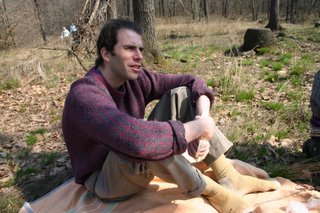Writing as Therapy
I’ve had a glass of juice, struggled to read a bit in Freakonomics, a book I just got and read some students’ test papers. I was falling asleep, so I reasoned that writing might just bring me around.
Monday night I was out at a St. Patrick’s Day party hosted by the Irish Embassy. Afterwards I was hanging out at a buddy’s place where I got a bit baked and found myself struggling to keep my wits. I managed to gather myself whenever I took up some far-out topics. Could this work now? What are some far-out topics? Sex on other planets? Sex between birds and hamsters? Money-making schemes based around sex between birds and hamsters on other planets? Perhaps those are too unrealistic.
I’ve got a good head for designing plans. The trouble I have is keeping myself together in order to implement them. There is a real chasm separating many ideas from their implementation. For example, I’ve had this idea lately to do a research study of Albania for business purposes. Real Estate development would seem to jump off the page as a place to start. After all, the population is not so large as to constitute a major market, hence limiting interest to foreign investors. But all that great Mediterranean coast is just begging for hotels and so forth. It occurred that what could be really interesting would be to set up something “hippy” along the lines of Butterfly Valley or Olympos; both on the south coast of Turkey. If a market study paid for by investors could feed the hippy project, then all the better. Folks could even be brought over from Turkey to get the hippy thing going.
Theres a woman here munching away on something very crunchy, rice cakes probably. There’s plasma TV in front of me with the sound down tuned to a business channel, playing “Squawk Box” a program about investment markets. In general, the people all looked spiked up on caffeine. Consciously putting on the right aggressively serious and optimistic face; the sort of face that says “Right. Here’s the way it is, aren’t we all important and cutting edge. Looking forward to golf at the weekend, but first the facts on the ground.”
I’ve got this idea that if large double-skinned geodesic domes were built the right way, they could make nifty spaceships. They could lift off without rockets and travel faster than the speed of light once out in space. Something like the deathstar only kinder and gentler.
Now Squawk Box is interviewing a German guy in Berlin, standing outside with chracteristic stone buildings and construction equipment behind him talking about “the EU at 50.” That’s an interesting number, no? It seems they’re tracing back the EU’s life to those post-war trade agreements stemming forward from Bretton Woods. But the entity known as the EU is, what, ten to fifteen years old?
Dude in a cream suit with a mustache sat down to wait for the same guy as me. He ordered a coffee from the receptionist.
I’m beginning to think I should photocopy my diploma, give it to the receptionist, pack and go.
Steve – Istvan – my student just arrived. He has a meeting with someone so I can chill for a bit. But just seeing him, knowing that a coffee and a chat is yet to come lifts my spirits quite a bit. The dull aspects of life – the papers I have to grade, money issues, the BBJ intelligence service; all this seems less significant and far less of a burden in light of Steve. Steve is a man who’s made things happen in his life by working with a team of devoted professionals. I, too, have made things happen. But my style has been different. I’ve worked with other people, but at a distance and under different terms than in an office. My life has had its complications, but with the help of Yoga and meditation and vegetarianism, all has taken shape so that all is well and I am grateful for it all and happy with the way it is.
I glanced up at the TV and saw a “house ad” for their midday show, “Power Lunch.” How sickening! If I ran the channel I’d have shows with names like “Eleventh Hour Briefing”, “Blind Greed,” and “The Follower’s Day-job”


